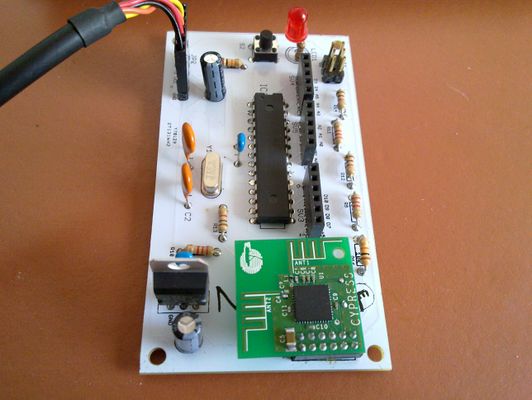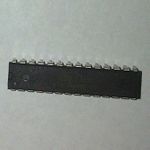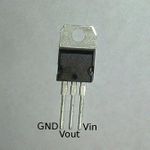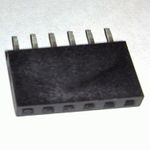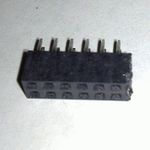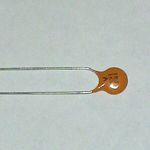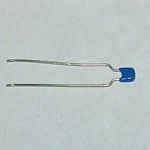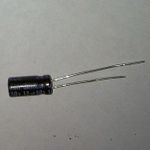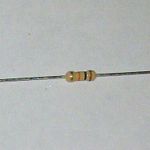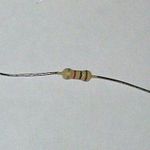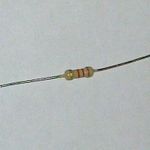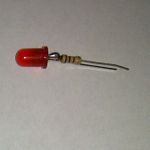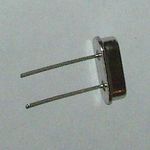Nurduino: Difference between revisions
No edit summary |
|||
| Line 8: | Line 8: | ||
Nurduino is our very own [http://en.wikipedia.org/wiki/Arduino arduino] clone. It is the evolution of the [[Arduino Radio Spectrum Analyzer prototype on a breadboard]] project. In that project I built a prototype of the Nurduino, and tried to share the how's and why's. | Nurduino is our very own [http://en.wikipedia.org/wiki/Arduino arduino] clone. It is the evolution of the [[Arduino Radio Spectrum Analyzer prototype on a breadboard]] project. In that project I built a prototype of the Nurduino, and tried to share the how's and why's. | ||
In this page I will make a shorted description of how to build the Nurduino kit, and use it as a 2.4GHz Radio Analyzer. | In this page I will make a shorted description of how to build the Nurduino kit, and use it as a 2.4GHz Radio Analyzer. | ||
== Attention (errata) == | |||
* At the LED1 location on the PCB the wrong hole is marked with a + sign. This is actually the GND hole. The other hole should contain the + leg of the LED. | |||
* In the PCB design, a mistake has been made by forgetting a resistor for the LED. We therefore soldered a 1k resistor to the + leg of the LED. For those who buy the kit complete, you receive a pre-assembled LED, so you don't need to worry. Others: please attach the resistor to the LED or you could burn out not only your LED but also your Atmega328 ICU! | |||
== What do I need == | == What do I need == | ||
| Line 13: | Line 17: | ||
* Solder. I use 0.7mm (more accurate then 1mm) with a resin core, containing lead (was your hands and try not to breathe the fumes). | * Solder. I use 0.7mm (more accurate then 1mm) with a resin core, containing lead (was your hands and try not to breathe the fumes). | ||
* [https://www.sparkfun.com/products/9718 FTDI cable] or [http://www.adafruit.com/products/284 FTDI friend] (and micro usb cable) to connect the board to the usb port. | * [https://www.sparkfun.com/products/9718 FTDI cable] or [http://www.adafruit.com/products/284 FTDI friend] (and micro usb cable) to connect the board to the usb port. | ||
== Software == | |||
* To program the atmega chip, you need [http://nurdspace.tk/~smokeyd/nurduino_spectrum_analyzer.ino this sketch]. | |||
* The full schematic and pcb design of the Nurduino can be found [http://nurdspace.tk/~smokeyd/2.4GHz_radio_analyzer.zip in this zipfile]. | |||
== Kit components == | == Kit components == | ||
| Line 52: | Line 60: | ||
|- | |- | ||
|} | |} | ||
== Putting it together == | == Putting it together == | ||
If this is your first time soldering: don't worry, it is actually not hard. I learnt it from [https://www.noisebridge.net/wiki/User:Maltman23 Mitch Altman], who is a great teacher and the co-author of [http://mightyohm.com/files/soldercomic/FullSolderComic_EN.pdf Soldering is easy]. | If this is your first time soldering: don't worry, it is actually not hard. I learnt it from [https://www.noisebridge.net/wiki/User:Maltman23 Mitch Altman], who is a great teacher and the co-author of [http://mightyohm.com/files/soldercomic/FullSolderComic_EN.pdf Soldering is easy]. | ||
Revision as of 00:43, 27 March 2013
| NURDspace Project | |
|---|---|
| Participants | |
| Skills | |
| Status | |
| Niche | |
| Purpose | |
| Tool | |
| Location | |
| Cost | |
| Tool category | |
{{{Name}}}Property "Tool Name" (as page type) with input value "{{{Name}}}" contains invalid characters or is incomplete and therefore can cause unexpected results during a query or annotation process. Property "Tool Image" (as page type) with input value "File:{{{Picture}}}" contains invalid characters or is incomplete and therefore can cause unexpected results during a query or annotation process. {{{Picture}}} {{#if:{{{Tool}}} | [[Tool Owner::{{{ProjectParticipants}}} | }} {{#if:{{{Tool}}} | [[Tool Cost::{{{Cost}}} | }}
Nurduino is our very own arduino clone. It is the evolution of the Arduino Radio Spectrum Analyzer prototype on a breadboard project. In that project I built a prototype of the Nurduino, and tried to share the how's and why's. In this page I will make a shorted description of how to build the Nurduino kit, and use it as a 2.4GHz Radio Analyzer.
Attention (errata)
- At the LED1 location on the PCB the wrong hole is marked with a + sign. This is actually the GND hole. The other hole should contain the + leg of the LED.
- In the PCB design, a mistake has been made by forgetting a resistor for the LED. We therefore soldered a 1k resistor to the + leg of the LED. For those who buy the kit complete, you receive a pre-assembled LED, so you don't need to worry. Others: please attach the resistor to the LED or you could burn out not only your LED but also your Atmega328 ICU!
What do I need
- A soldering iron (including sponge and stand). Use one that is accurate with a good tip. Although the pcb is setup with a lot of space there are a few spots where accuracy is required. Under €50 there are good options available.
- Solder. I use 0.7mm (more accurate then 1mm) with a resin core, containing lead (was your hands and try not to breathe the fumes).
- FTDI cable or FTDI friend (and micro usb cable) to connect the board to the usb port.
Software
- To program the atmega chip, you need this sketch.
- The full schematic and pcb design of the Nurduino can be found in this zipfile.
Kit components
Putting it together
If this is your first time soldering: don't worry, it is actually not hard. I learnt it from Mitch Altman, who is a great teacher and the co-author of Soldering is easy.

